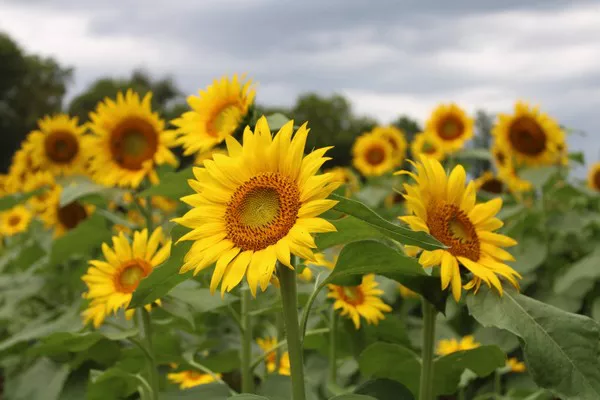Sunflowers (Helianthus annuus) are celebrated for their vibrant blossoms and towering presence in gardens, but beyond their ornamental value, these cheerful flowers offer an array of edible delights. From the petals to the seeds, sunflowers provide a versatile and nutritious addition to culinary creations. In this exploration, we delve into the various edible aspects of sunflowers, shedding light on the diverse ways these flowers can be enjoyed as a delightful and nutritious addition to the culinary world.
Sunflower Petals: A Splash of Color in Salads and Garnishes
The petals of the sunflower, with their bright and cheery hues, are not only visually appealing but also edible. Sunflower petals boast a mild, slightly bitter flavor, making them a delightful addition to salads and other dishes. The petals can be plucked and sprinkled over green salads to add a splash of color and a subtle, herbal taste. Their vibrant appearance also makes sunflower petals a beautiful garnish for desserts, appetizers, or even as a decorative touch on main courses, providing an edible floral accent to elevate the visual appeal of a dish.
Sunflower Buds: A Culinary Delicacy in the Making
Before sunflowers fully bloom into their iconic golden faces, the closed buds are another edible part of the plant. These buds have a similar taste to artichokes, with a nutty and slightly sweet flavor. Sunflower buds can be harvested when they are still tightly closed and used in various culinary applications. They can be pickled for a tangy addition to salads or antipasto platters, or sautéed and added to stir-fries or pasta dishes. The culinary potential of sunflower buds adds a unique and flavorful element to the dining experience.
Sunflower Seeds: Nutrient-Rich Powerhouses of Flavor
Perhaps the most well-known edible part of the sunflower is its seeds. Sunflower seeds are not only a popular snack but also a nutrient-rich ingredient that can be incorporated into a variety of dishes. These seeds are a rich source of healthy fats, protein, and essential vitamins and minerals. Roasted sunflower seeds make for a crunchy and flavorful topping for salads, yogurt, or oatmeal. They can also be ground into a paste and used as a base for spreads or incorporated into baked goods for added texture and nutrition. The versatility of sunflower seeds makes them a staple in both savory and sweet culinary endeavors.
See Also: How to make pressed flower art?
Sunflower Sprouts: A Nutrient-Packed Addition to Salads and Sandwiches
Sunflower sprouts, often grown from hulled sunflower seeds, are tender and flavorful additions to salads, sandwiches, and wraps. These young sprouts boast a mild nutty taste and a satisfying crunch. Packed with nutrients, including vitamins A and C, sunflower sprouts contribute a burst of freshness to culinary creations. They can be used as a base for salads, mixed into sandwiches for added texture, or even blended into smoothies for a nutrient boost. The delicate yet robust nature of sunflower sprouts makes them a versatile ingredient for those seeking to enhance the nutritional profile of their meals.
Sunflower Oil: A Heart-Healthy Culinary Companion
While not a direct part of the flower, sunflower oil is derived from the seeds and plays a significant role in the culinary world. Known for its mild flavor and high smoke point, sunflower oil is a popular choice for cooking, baking, and frying. It serves as a heart-healthy alternative to other cooking oils and can be used in a variety of dishes, from sautéed vegetables to salad dressings. The light and neutral taste of sunflower oil allows it to complement the natural flavors of ingredients without overpowering the dish, making it a versatile and health-conscious addition to the kitchen.
Sunflower Root Tubers: A Lesser-Known Culinary Gem
While not as commonly consumed as other parts of the sunflower, the root tubers can also be harvested and used in culinary endeavors. These tubers have a starchy and slightly sweet taste, reminiscent of other root vegetables like potatoes or sweet potatoes. They can be roasted, boiled, or mashed, providing a unique twist to traditional side dishes. While not as mainstream as other parts of the sunflower, the root tubers showcase the plant’s culinary diversity and offer a creative option for those looking to experiment with lesser-known edible components.
Conclusion
In the world of edible flowers, sunflowers stand out not only for their visual appeal but also for their diverse and flavorful contributions to the culinary landscape. From the vibrant petals to the nutrient-rich seeds, each part of the sunflower offers a unique culinary experience. As chefs and home cooks alike continue to explore innovative ways to incorporate edible flowers into their dishes, sunflowers emerge as a versatile and nutritious choice, providing a burst of flavor, color, and vitality to a wide array of culinary creations. Whether enjoyed as a snack, a garnish, or a central ingredient, sunflowers bring a touch of culinary sunshine to the dining table.


